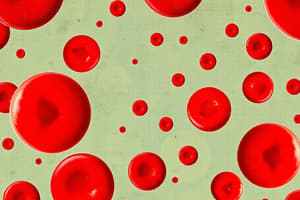Podcast
Questions and Answers
Which cells are nucleated precursors in the bone marrow?
Which cells are nucleated precursors in the bone marrow?
- Proerythroblast (correct)
- Rubriblast
- Pronormoblast
- Reticulocyte
What is the process of erythrocyte production called?
What is the process of erythrocyte production called?
- Erythroblasts
- Normoblasts
- Erythropoiesis (correct)
- Hemoglobin production
Which stage of erythroid development has a high N:C ratio, open chromatin, and dark blue cytoplasm?
Which stage of erythroid development has a high N:C ratio, open chromatin, and dark blue cytoplasm?
- Pronormoblast
- Proerythroblast (correct)
- Rubriblast
- Reticulocyte
What are the specific functions of the cellular organelles in mature erythrocytes?
What are the specific functions of the cellular organelles in mature erythrocytes?
Which subdivision of the nervous system consists of the brain and spinal cord?
Which subdivision of the nervous system consists of the brain and spinal cord?
What is the function of the sensory division of the nervous system?
What is the function of the sensory division of the nervous system?
What is the function of the motor/effector division of the nervous system?
What is the function of the motor/effector division of the nervous system?
What is the structural organization of the nervous system?
What is the structural organization of the nervous system?
What is a group of nerve fibers traveling together in the Central Nervous System (CNS) called?
What is a group of nerve fibers traveling together in the Central Nervous System (CNS) called?
Flashcards are hidden until you start studying
Study Notes
Hematopoiesis
- Hemocytoblasts are nucleated precursors in the bone marrow.
Erythropoiesis
- Erythropoiesis is the process of erythrocyte production.
- The basophilic erythroblast stage of erythroid development has a high nucleus-to-cytoplasm (N:C) ratio, open chromatin, and dark blue cytoplasm.
Erythrocyte Structure and Function
- Mature erythrocytes lack most cellular organelles, but contain a membrane-bound enzyme, carbonic anhydrase, which catalyzes the hydration of CO2.
- Erythrocytes have a flexible membrane skeleton, which allows them to change shape and pass through narrow blood vessels.
Nervous System Organization
- The central nervous system (CNS) consists of the brain and spinal cord.
- The sensory division of the nervous system transmits and processes information from sensory receptors to the CNS.
- The motor/effector division of the nervous system transmits signals from the CNS to effectors (muscles and glands) to produce a response.
Nerve Structure
- A group of nerve fibers traveling together in the CNS is called a tract.
- A bundle of nerve fibers outside the CNS is called a nerve.
Studying That Suits You
Use AI to generate personalized quizzes and flashcards to suit your learning preferences.




